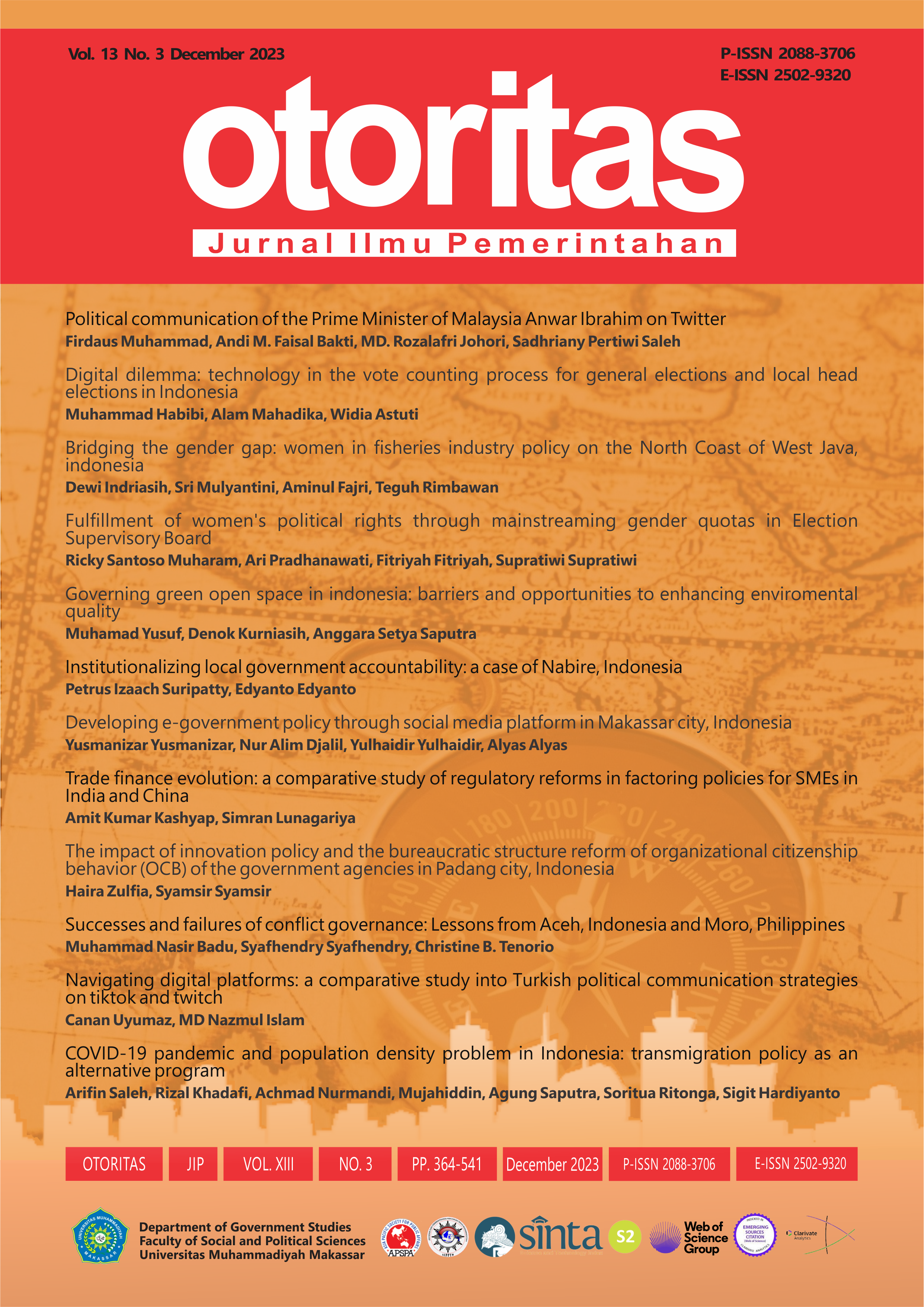Digital dilemma: technology in the vote counting process for general elections and local head elections in Indonesia
DOI:
https://doi.org/10.26618/ojip.v13i3.12729Keywords:
digital dilemma, general election, situng, sirekapAbstract
The traditional methods of vote counting and recapitulation, which include manual and layered processes, are important to ensuring data security and addressing a lack of understanding of public information technology. However, it is essential to quickly and properly disseminate election results among an increasing number of survey findings within the community. Despite this contradictory scenario, it is imperative to employ information technology tools like SITUNG and SIREKAP to ensure transparent dissemination of election outcomes. The study applies a descriptive qualitative approach, collecting primary and secondary data sources including official documents, journal articles, and textbooks. By using three analysis techniques; first, by tabulating the data; second, to categorize the data; third, interpreting the findings based on the theoretical and construction of the data. The results of this study showed three main challenges to the use of digital-based recapitulation: first, the lack of a clear legal basis for the SITUNG and SIREKAP applications, which has triggered criticism from election participants and observers; second, incomplete system support characterized by limited network connectivity, which has created difficulties for field operators in the local level; and third, inappropriate data management in the SITUNG and SIREKAP applications, which included incorrect data entry. Election organizers should be aware that technology-based recapitulation data can become digital evidence for contesting parties in election courts.
References
Alamsyah, D. P. S., Windyanti, A. M., & Nugroho, D. A. (2020). Analisis Efisiensi Perhitungan Suara Pemilu dengan metode Quick Count, Real Count dan Exit Poll. Mimbar Keadilan, 13(2), 229–239. https://doi.org/10.30996/mk.v13i2.3676
Alvarez, R. M., Hall, T. E., & Trechsel, A. H. (2009). Internet Voting in Comparative Perspective: The Case of Estonia. PS - Political Science and Politics, 42(3), 497–505. https://doi.org/10.1017/S1049096509090787
Amrullah, A., Subhilhar, S., & Amin, M. (2021). Profesionalisme Penyelenggara Adhoc dalam Keberatan Saksi di Tahapan Rekapitulasi Hasil Penghitungan Suara Tingkat Kecamatan. Perspektif, 10(2), 321–344. https://doi.org/10.31289/perspektif.v10i2.4426
Asgar, S. (2019). Kebijakan Produk Hukum pada Pelaksanaan Pemungutan dan Perhitungan Suara Pemilu 2019. Hibualamo: Seri Ilmu-Ilmu Sosial Dan Kependidikan, 3(2), 106–114. http://journal.unhena.ac.id/index.php/HibSos/article/view/149
Asosiasi Penyelenggara Jasa Internet Indonesia. (2020). Laporan Survei Internet APJII 2019 - 2020 (Q2). In Asosiasi Penyelenggara Jasa Internet Indonesia and Indonesia Survey Center. https://apjii.or.id/survei
Azizah, A. H. (2018). Teknologi Pada Keinginan Masyarakat Dalam Mengadopsi E-Voting. Jurnal Ilmiah Teknologi Informasi Terapan, 4(2), 109–115. https://doi.org/10.33197/jitter.vol4.iss2.2018.156
Birch, S. (2011). Electoral Malpractice. OxfordUniversity Press.
Birch, S., Daxecker, U., & Höglund, K. (2020). Electoral Violence: An Introduction. Journal of Peace Research, 57(1), 3–14. https://doi.org/10.1177/0022343319889657
Dorpenyo, I. K. (2019). Risky Election, Vulnerable Technology: Localizing Biometric Use in Elections for the Sake of Justice. Technical Communication Quarterly, 28(4), 361–375. https://doi.org/10.1080/10572252.2019.1610502
Duile, T. (2021). Challenging Hegemony: Nurhadi-Aldo and the 2019 Election in Indonesia. Journal of Contemporary Asia, 51(4), 537–563. https://doi.org/10.1080/00472336.2020.1748896
Febriani, I. (2020). Struktur Percakapan dalam Sidang Sengketa Pilpres 2019 Saksi Ahli Paparkan Situng. Jurnal Metabasa, 2(1), 38–50. http://jurnal.unsil.ac.id/index.php/mbsi/article/view/1804
Habibi, M. (2018). Dinamika Implementasi E-Voting di Berbagai Negara. https://doi.org/10.31227/osf.io/bu2ax
Habibi, M. (2021). Pandemic Democracy: Impact Regional Elections Held During the COVID-19 Pandemic. Journal Government and Political Issues, 1(1), 15–25. https://doi.org/10.53341/jgpi.v1i1.1
Huntington, S. P. (1991). The Third Wave: Democratization in the Late 20th Century. Journal of Democracy, 2(2), 384. https://doi.org/10.1353/jod.1991.0016
Husin, L. H., Pratama, H. M., Prasetyo, W., Hendra, H., Darmawan, W. B., Manan, F., & Amsari, F. (2021). Malpraktik Pemilu dan Korupsi: Analisis terhadap Proses Penghitungan dan Rekapitulasi pada Pemilu Indonesia 2019. INTEGRITAS: Jurnal Antikorupsi, 7(1), 57–78. https://doi.org/10.32697/integritas.v7i1.720
Maharani, T. (2020). Diperkenalkan GENERAL ELECTION COMMISSIONS, Sirekap Akhirnya Batal Digunakan di Pilkada 2020. News.Detik.Com. https://nasional.kompas.com/read/2020/11/13/08040161/diperkenalkan-General Election Commissions-sirekap-akhirnya-batal-digunakan-di-pilkada-2020?page=all
Mahpudin. (2019). Teknologi Pemilu, Trust, dan Post Truth Politics: Polemik Pemanfaatan SITUNG (Sistem Informasi Penghitungan Suara) Pada Pilpres 2019. Jurnal PolGov, 1(2), 157. https://doi.org/10.22146/polgov.v1i2.55886
Neuman, W. L. (2017). Social Research Methods: Qualitative and Quantitative Approaches (Seventh Ed). Pearson Education Limited. http://letrunghieutvu.yolasite.com/resources/w-lawrence-neuman-social-research-methods_-qualitative-and-quantitative-approaches-pearson-education-limited-2013.pdf
Prabowo, H., Syafri, W., & Juanda, J. (2021). Pandemic At the Polls: Preparement and Arrangement of Indonesian Regional the Election in the Midst of Covid-19. International Journal of Management, 11(12), 2189–2199. https://doi.org/10.34218/ijm.11.12.2020.206
Purnawan, H. (2019). Bawaslu Putuskan GENERAL ELECTION COMMISSIONS Langgar Tata Cara Input Situng. Bawaslu.Go.Id.
Ramadhan, A. P., Fitriani, A. P., Suharto, S., & Hendrastiti, T. K. (2018). Electronic Voting in Indonesia: Head of Village Election. Jurnal Sosial Politik, 4(2), 73. https://doi.org/10.22219/sospol.v4i2.6150
Undang-undang Nomor 7 Tahun 2017, (2017). https://kesbangpol.palangkaraya.go.id/wp-content/uploads/sites/16/2017/08/UU-Nomor-7-Tahun-2017-Pemilihan-Umum.pdf
Risnanto, S., Rohim, Y., & Herman, N. (2019). Polling Stations Secure Scheme For e-Voting System in Indonesian General Election. Ahmad Dahlan International Conference Series on Engineering and Science (ADICS-ES 2019) Polling, 189, 18–21. https://doi.org/10.2991/adics-es-19.2019.5
Safitri, E. (2019). GENERAL ELECTION COMMISSIONS Patuhi Putusan Bawaslu soal Perbaikan Tata Cara Input Situng. News.Detik.Com. https://news.detik.com/berita/d-4552106/General Election Commissions-patuhi-putusan-bawaslu-soal-perbaikan-tata-cara-input-situng
Seftyanto, D., Amiruddin, A., & Hakim, A. R. (2019). Design of Blockchain-Based Electronic Election System Using Hyperledger: Case of Indonesia. 2019 4th International Conference on Information Technology, Information Systems and Electrical Engineering, ICITISEE 2019, 6, 228–233. https://doi.org/10.1109/ICITISEE48480.2019.9003768
Septianto, B. (2019a). GENERAL ELECTION COMMISSIONS Loloskan 40 Lembaga Survei Lakukan Quick Count Pemilu 2019. Tirto.Id. https://tirto.id/General Election Commissions-loloskan-40-lembaga-survei-lakukan-quick-count-pemilu-2019-dmeP
Septianto, B. (2019b). Mengapa Situng GENERAL ELECTION COMMISSIONS Bermasalah dan Bagaimana Implikasinya? Tirto.Id. https://tirto.id/mengapa-situng-General Election Commissions-bermasalah-dan-bagaimana-implikasinya-dKS6
Setiadi, A. (2014). Pemanfaatan Media Sosial untuk Efektifitas Komunikasi. Cakrawala: Jurnal Humaniora, 16(1). https://doi.org/10.31294/jc.v16i2.1283
Sinamora, J. (2019). Menyongsong Rezim Pemilu Serentak. Jurnal RechtsVinding, 3(4), 1–18. https://rechtsvinding.bphn.go.id/artikel/ART 1 JRV 3 NO 1 PROTECT.pdf
Sujadmiko, B., Panggar, I. P., Sofyansah, A., & Meutia, I. F. (2020). The Concept of E-Voting Mechanism Based on Law of General Election and Information Security. Jambe Law Journal, 3(1), 19–36. https://doi.org/10.22437/jlj.3.1.19-36
Surbakti, R., Supriyanto, D., & Asy’ari, H. (2011). Menjaga Integritas Pemungutan dan Penghitungan Suara (S. Pramono (ed.); Edisi Pert). Kemitraan bagi Pembaruan Tata Pemerintahan.
Sustikarini, A. (2020). Digital Democracy in Indonesia’s 2019 Election: Between Citizen Participation and Political Polarization. International Conference on Agriculture, Social Sciences, Education, Technology and Health (ICASSETH 2019), 429, 238–242. https://doi.org/10.2991/assehr.k.200402.055
Tampubolon, F. D. G., Amin, M., & Harahap, H. (2021). Pengaruh Informasi Sistem Penghitungan Nasional Online pada Hasil Pemilu 2019 terhadap Kepercayaan Publik Kota Medan. Perspektif, 10(2), 399–415. https://doi.org/10.31289/perspektif.v10i2.4601
Winarno, A., Harsari, J., & Ardianto, B. (2018). Block-Chain Based E-Voting For Indonesia. Journal of Engineering and Science Research, 2(5), 13–17. https://doi.org/10.26666/rmp.jesr.2018.5.3
Wulolo, C. M., & Renmaur, E. S. (2019). Meredam Konflik dalam Pusaran Siber dalam Proses Penetapan Hasil Rekapitulasi Pemilu Serentak 2019. Jurnal Penelitian Politik, 16(2), 111–235.
Zerback, T., Reinemann, C., & Barnfield, M. (2021). Total Recall? Examining the Accuracy of Poll Recall during an Election Campaign. Mass Communication and Society, 1–23. https://doi.org/10.1080/15205436.2021.1936559
Zhu, Y. Q., Azizah, A. H., & Hsiao, B. (2021). Examining Multi-dimensional Trust of Technology in Citizens’ Adoption of E-voting in Developing Countries. Information Development, 37(2), 193–208. https://doi.org/10.1177/0266666920902819
Zuhro, R. S. (2019). Demokrasi dan Pemilu Presiden 2019. Jurnal Penelitian Politik, 16(1), 69–81. https://doi.org/10.14203/jpp.v16i1.782
Downloads
Published
Issue
Section
License
The Editorial Team of Otoritas: Jurnal Ilmu Pemerintahan reserves the right to transfer the copyright of the article once it has been accepted and a decision has been made to publish it.
Department of Government Studies, Faculty of Social and Political Sciences, Universitas Muhammadiyah Makassar in collaboration with Muhammadiyah’s College Association of Government Studies (AIPPTM) and Asia Pacific Society for Public Affairs (APSPA) as the publisher of Otoritas: Jurnal Ilmu Pemerintahan holds the copyright of all articles published in this journal.
The Publisher holds the right to reproduce and distribute the article and author is not allowed to publish the same article published in this journal.
Statement of Authenticity and Manuscript Copyright can be downloaded: here
After filling in the statement letter, please send via e-mail: otoritas@unismuh.ac.id






